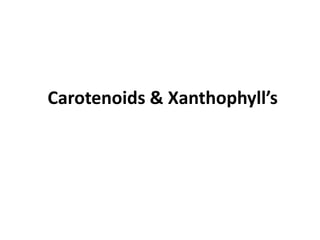
Carotenoids & Xanthophyll’s.pptx
- 2. Carotenoids Carotenoids are the fat soluble pigments Carotenoids are lipids compounds range in colour from yellow to purple . They are nearly found in all the higher plants There are two types of carotenoids • Carotenes • Xanthophyll's
- 3. Carotenes • These are pure hydrocarbon composed of eight same elements. • The term carotene is basically used for the unsaturated hydrocarbons substances. • They are mainly synthesized in the plant. • These can not be synthesized in the animals except spiders and aphids. • These animals gets the genes from the fungi .
- 4. Function of the Carotenes There are following functions of the carotenes • Carotenes are responsible for the orange colour of the carrot. • They are responsible for the colour of many fruits and vegetables. • They are also responsible for the orange color of the dry foliage. • They also give the yellow coloration to the milk and butter.
- 5. Production of the Carotenes There are two methods of the productions of the carotenes artificially • Witting reaction • Grignard reaction
- 6. Food Additive’s • Carotenes is also used as a substance to colour the products as juices , cakes deserts, butter and margarine. • It is approved as the food additive in the EU and New Zealand.
- 7. Carotenes is present in • Carotenes are present in the palm oil, in the corn , in the milk , of the dairy cows and the yellow color of the milk depend upon the feed of the cow and amount of the fat in the milk. • Carotenes is also present in some species of the termites where they are apparently picked up by the diet of the insects.
- 8. Xanthophyll's • These are oxygen containing hydrocarbons. • These are the yellow pigments. • These widely occur in the nature. • The word xanthophyll is derived from the Greek word xanthose and phyllon due to the formation of the yellow bands seen in the chromatography of the plant pigments.
- 9. Presence of Xanthophyll's • Xanthophyll's are present in highest quantity in the leaves of the green plants. • There act to modulate the light. • It also act as a non photochemical quenching agent to deal with the triplet chlorophyll which is produced in the high quantity in the photosynthesis. • They are also found in the bodies of the animals and human and in the dietary animal products which are derived from the plant source in the diet.
- 10. Difference between Xanthophyll's & Carotenes • As both the xanthophyll's and carotenes are similar in the structure. • But the xanthophyll's contains the oxygen atoms. • The carotenes have no oxygen atoms.
- 11. Collective function of the Carotenoids • The carotenoids are embedded in the protein by the non covalent bond. • The carotenoids play two important role in the plants. • They protect the photosynthetic member against the damage by the light and by the large amount of the energy which is absorbed by them. • They absorb the light energy and transfer it to the chlorophyll a. • Therefore they are also called the accessory pigments. • They also play important role in determining the parameters of the fruits and vegetables.
- 12. • The carotenoids are responsible for the yellow orange , and red hues of the fruits and flowers. • They are also responsible for the colour of the many birds. • They are also responsible for the colour of the fishes crustaceans and insects. • They are partially responsible for the fall coloration after the leaf chlorophyll has been destroyed. • Animals are unable to synthesize the carotenoids.
- 13. Classification Carotenoids are classified into two types • The hydrocarbon without oxygen which are called carotenes. • The oxygenated carotenoids which are known as the xanthophyll's.
- 14. Structure • Carotenoids are lipid soluble c40 tetrapenoids. • The majority of the carotenoids are derived from the 40 Carbon polyene chain. • Which could be considered as the backbone of the molecule. • This chain may be terminated as the cyclic end group or can be terminated by a oxygen containing functional group.
- 15. Other Examples of Carotenoids These are following examples • Antheraxanthine • This is present in the plants especially in the maize • Astaxanthine • Present in the salmon shrimp and lobsters • Canthaxanthine • Present in the flamingo feathers
- 16. THANK YOU